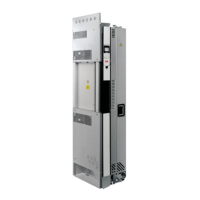134 Electrical installation
Connection procedure of the motor cables
WARNING! Repeat the steps described in section Electrical safety
precautions on page 128. The complete safety instructions are given in
Safety instructions for ACS880 multidrive cabinets and modules
(3AUA0000102301 [English]). If you ignore them, physical injury or death, or damage to
the equipment can occur.
WARNING! With aluminum cables, apply grease to stripped conductors before
attaching them to non-coated aluminum cable lugs. Obey the grease
manufacturer’s instructions. Aluminum-aluminum contact can cause oxidation in
the contact surfaces.
1. Ground the inverter modules by the top edge of the front plate. The grounding point is
marked on the module. Connect the front plate to the frame support bracket with
screws. The bracket should have a galvanic connection to the PE busbar through the
cabinet frame.
Notes:
• If the cabinet frame is painted (such as with Rittal TS 8 enclosures), it is important
to make sure that a good galvanic connection to ground (PE busbar) is achieved.
You can, for example, remove the paint from the connection points and use star
washers.
• The connection to ground merely through the mounting screws and the cabinet
chassis is not always good enough. To ensure the continuity of the protective
bonding circuit, you can connect the modules to the cabinet PE busbar with a
copper busbar or cable. The inductance and impedance of the PE conductor must
be rated according to permissible touch voltage appearing under fault conditions
(so that the fault point voltage will not rise excessively when a ground fault
occurs). See Electrical planning instructions for ACS880 multidrive cabinets and
modules (3AUA0000102324 [English]).
2. Run the output (motor) cable into the cubicle through a cable gland or grommet. 360°
grounding of the cable shield is recommended to suppress interference. In case a
grounding cable gland is available, remove the outer jacket of the cable where it
passes through the cable gland.
3. Cut the output cable to suitable length and strip the ends of the individual conductors.
4. Twist the shield strands of the output cable together to form a separate conductor and
wrap tape around it as shown.

